This article covers the Jiri variation to the Everest Base Camp by providing detailed maps, itinerary and by answering various question on the logistics of the trek, the best times to trek, what to pack and more.
The Jiri to Everest Base Camp Trek could be considered the ‘purest’ and most authentic trek in the region as it follows the same trails that the early pioneers in the 1950s would have used. Instead of taking the short flight from Kathmandu to Lukla, the Jiri variation starts with a 7-hour long bus ride to the town of Jiri where the trek begins.
Before the Lukla airport was built by the famous Sir Edmund Hillary and his associates, reaching what is now considered the starting point for most Everest treks involved hiking for a week through the countryside of the Solu Khumbu region. From Lukla, the trek follows the classic Everest Base Camp Trek through the towns of Phadking, Namche Bazaar, Tengboche, Pheriche and Gorak Shep before reaching Everest Base Camp situated on the south side of the mountain.
The trek is popular among individuals looking for an extended stay in the Himalayan countryside and a greater exposure to the real-life workings of the Sherpa people and their culture, untainted by the more popular tourist route that will be encountered later on the trek. The Jiri variation is also the only alternative to taking the nerve-racking flight into Lukla – not a flight for the easily unsettled!
Highlights of the trek include the first week spent chiefly in the Solu Khumbu region among pristine terraced farmlands, forests and the beautiful Dudh Koshi River. Most of the Sherpa people live in this region so expect to encounter the friendly hospitality of the locals while you learn about their culture and customs as you slowly acclimatise to the high altitude.
Past Lukla you will be greeted with breath-taking views of Everest and the surrounding peaks as you make your way up the Khumbu Valley towards base camp. Mingle with some potential summiteers at base camp before ascending Kala Patthar, the iconic viewpoint of the region.
Get a Trek Quote
We do not sell tours, we simply provide impartial advice. If you would like an exact quote from our recommended tour operator click Get a Quote.
Jiri to Everest Base Camp
Regional Map
The Khumbu or Everest region of Nepal is indicated by the orange block on the map below. After flying into Kathmandu, the capital, a bus ride will take you to Jiri, which is located almost half way between Kathmandu and Lukla – close to the number 9 on the map.
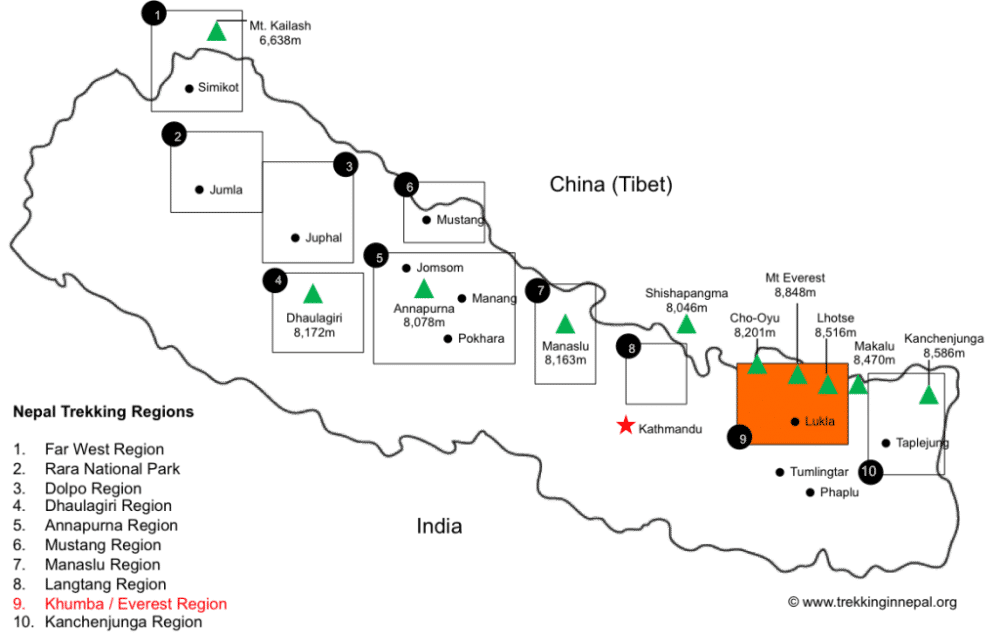
The Jiri to Everest Base Camp Trek takes you through the lower altitude region of Solu Khumbu up towards Lukla before joining up with the classic trek which heads north towards Everest Base Camp.
Trekking Map
This not-to-scale map provides an overview of the Jiri to Everest Base Camp Trek by showing the main stops along the way and their respective altitudes. The trek starts at Jiri in the south-west before heading north-east through the Solu Khumbu region to Lukla, passing the towns of Sete, Junbesi and Numtala before reaching Surkhe, just below Lukla. From here the trek moves north to Phadking where it follows the classic Everest Base Camp Trek by hugging the right-most route on the map.
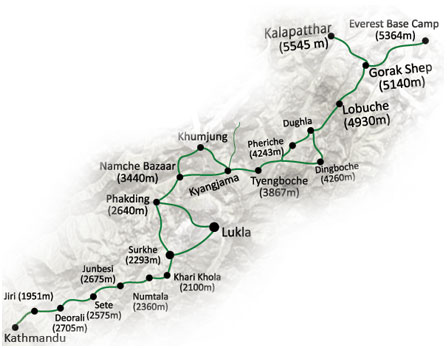
Once the high-points of Everest Base Camp and Kala Patthar have been reached, the trek backtracks on the same route down the Khumbu Valley to Lukla where a flight will take you back to Kathmandu. You only trek the Jiri-Lukla section on the outwards leg.
Recommended Guidebooks
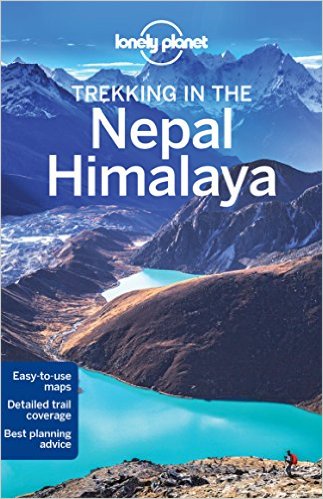
It is a good idea to bring along a detailed guide for the trek as it is often hard to know which sights to check out or which routes to follow.
Even if you are going on a guided tour, most guide maps provide great background reading material that will help you get up to speed on the history of the region.
We recommend the Lonely Planet Trekking in Nepal Himalaya guide as it is updated regularly and contains information about a variety of treks in the region.
In terms of a map we recommend Nepa Maps 1:100,000 Jiri to EBC Map
Detailed Itinerary
As with all treks in the Everest region, your journey will start in Kathmandu where the international airport is located. From there you will embark on a scenic bus ride through the hilly countryside. After 7 hours, you will have arrived in Jiri where the actual trekking begins.
Out of the 22-day journey, 18 days will be spent trekking for an average of 5/6 hours per day. The remaining days are spent travelling or acclimatizing to the high altitudes of the region.
The return leg of the trek follows the classic route back to Lukla where you will catch a flight back to Kathmandu, meaning the Jiri trek only varies from the classic trek in the outwards leg. The trek would become very long and tiring if you had to complete the Jiri-Lukla portion of the trek on both the outwards and inwards legs!
Day 1: Arrive in Kathmandu
Arrive in Kathmandu airport after a typically long flight from back home. Spend the rest of the day relaxing in your hotel or exploring the capital city of Nepal.
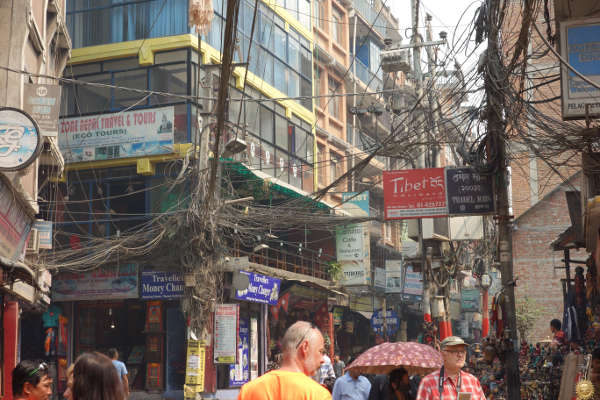
Vibrant streets of Thamel, Kathmandu
Day 2: Bus ride to Jiri
After an early-morning breakfast, depart on the 190km bus ride through the foothills of the Himalayas. After you leave the Kathmandu Valley you will be greeted with scenic views of the Sun Koshi River as you drive on the Swiss-built road to Jiri. The picturesque journey takes about 7-8 hours to complete on the mountain roads.
You will spend the night in the small riverside town of Shivalaya, just past Jiri.
Day 3: Jiri (Shivalaya) via Deorali Pass to Bhandar
The day starts with a river crossing on a suspension bridge before passing various tea houses that provide you with the opportunity to interact with the locals. As you proceed through the Deorali Pass you will see the many prayer flags and decorated walls that indicate your entry into a region of Tibetan culture.
After traversing the pass, you descend to Bhandar where you will sleep for the night.
Day 4: Bhandar to Sete via Lamjura Pass
The route takes you through some village fields before crossing a small stream that signifies the start of the forest. As you leave the forest, be sure to buy a walking stick from one of the local children as it can come in handy when tackling the steep descent you now face!
After the small Sherpa village of Kenja is reached, you start ascending the steep Lamjura Pass that brings you to the town of Sete.
Day 5: Onto Jumbesi
Another climb of the Lamjura Pass through forest of pine, magnolia and rhododendrons will provide you with great panoramic views of the region.
Descend the other side of the pass through fragrant forests full of fir and hemlock, which lead you to Junbesi, one of the largest towns in the area.
Day 6: Cross Ringmo Khola and hike to Nunthala
Head up the valley through the forest again, where you will catch your first sighting of Everest and the surrounding peaks. The closer mountains will appear much taller than Everest at first.
Cross the suspension bridge of Ringmo Khola then ascend to the village of Ringmo, where you will pass extraordinary examples of Tibetan architecture. Descend through one more dense forest packed full of life before reaching Nunthala where you will spend the night.
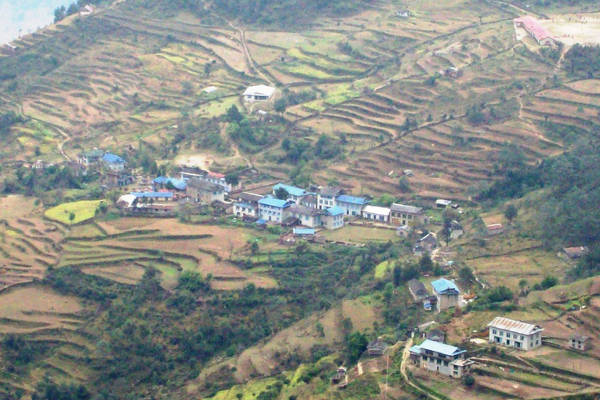
Day 7: Numthala to Bupsa
Shortly after leaving Nunthala you will reach the Dudh Koshi River – Milk River in Nepali. You will see why as you cross the suspension bridge above the foaming white rapids of the river.
From here you turn north and head towards the overnight destination of Bupsa – a gradual ascent up the valley.
Day 8: Finally you make your way to Lukla
From now the remainder of the trek will be largely uphill as you slowly make your way to the base camp. The day starts with an ascent through a forest bustling with monkeys and verdant foliage before reaching some barren hillside.
You will pass some small villages before you reach Surkhe, a small village located just below the Lukla airstrip.
Days 9-22 follow the same route as the classic Everest Base Camp Trek which can be found here.
Get a Trek Quote
We do not sell tours, we simply provide impartial advice. If you would like an exact quote from our recommended tour operator click Get a Quote.
Jiri to EBC Trek FAQ
How much does the Jiri to EBC Trek Cost?
The typical Jiri to Everest Base Camp Trek will cost in the region of £1,500 to £2,500. These are guided tour packages that will include all board and lodging, travel expenses, guides and porters and meals on the trip. We recommend using a western based guide that is charging around £2,000 per person, as packages cheaper than this are likely to be of a lesser quality due to cost cutting.
Tour packages will not include the cost of a Nepal visa – US$ 40 for a one month multi entry visa. They will also not cover and travel insurance expenses or personal expenses on the trip.
When is the best time to trek from Jiri to EBC?
The peak season for the Jiri to Everest Base Camp Trek will be the same as for the other Everest treks – February to May and September to October.
During these months either side of summer, the weather is likely to be stable and dry – making for great trekking conditions. The peak summer months will be extremely wet due to the coinciding monsoon season so we do not recommend trekking then. Winter treks are possible although some paths may be closed so it is not recommended to trek during winter.
How long is the trek from Jiri to Lukla?
The hiking distance from Jiri to Lukla is about 50 km (31 miles). Most people walk this in 5-6 days.
How difficult is the trek?
The trek does not involve any technical climbing nor does it require any previous experience of climbing, meaning it is achievable for all. That being said, the Jiri variation is significant longer than the classic Everest Base Camp Trek, making it slightly more challenging.
Expect to trek 15km per day over the course of 5/6 hours. This is a number that can be achieved with a little bit of prior training and practice hikes. See our detailed training article for information on how to train.
Will I get altitude sickness?
The trek has been engineered to provide enough time to acclimatize to the higher than normal altitudes of the region. The first week of trekking to Lukla involves many days of ascent followed by descent, so that by the time you reach Lukla you would have been adequately acclimatized.
Altitude sickness can affect anyone regardless of age and fitness level so we still insist that you read up on the sickness and its symptoms before embarking on the trek. Our article on altitude sickness and acclimatization is sufficient preparation reading.
Get a Trek Quote
We do not sell tours, we simply provide impartial advice. If you would like an exact quote from our recommended tour operator click Get a Quote.
What gear should I pack for the Jiri Trek?
The packing list for a trek of this duration is quite extensive so we have compiled a complete packing list for Everest treks, in which we provide some brands that we recommend due to past experience trekking in the region.
What insurance do I need?
Yes, trekking at altitude in Nepal comes with various risks that will not be covered by typical travel insurance policies. We recommend taking out insurance that covers trekking up to altitudes of 6,000m as well as any trekking related injuries and altitude related sicknesses.
Read our detailed insurance guide that aims to help you find the best policy for this type of trek.
Alternatively, check out the adventure travel insurance specialist - Rise & Shield. They offer cover for hiking up to 6,500m on their Adventure Extreme pack.
Route Variations
Classic EBC Trek
The most popular trek in the region, the classic Everest Base Camp Trek starts after a flight into Lukla. From there the hike begins with gradual ascents each day through various villages and small towns as you head north through the Khumbu Valley.
The trek takes you through the villages of Phadking, Namche Bazar, Tengboche, Pheriche and Gorak Shep before reaching the Everest Base Camp. You then retrace your footsteps as you head back down the valley, using the same route.
The trek is very popular during peak trekking season with over 30,000 people completing it annually. It typically lasts 14 days and covers 130km of trekking that involves covering an average of 15km per day over 5/6 hours.
Gokyo Lakes Trek
One of the more popular variations of the Everest Base Camp Trek, the Gokyo Lakes Trek, also starts at Lukla and follows the classic base camp trek to Namche Bazar where it forks north-west.
The trek proceeds through the towns of Dole and Machhermo before reaching the stunning Gokyo Lakes. From there you ascend to the peak of Gokyo Ri in the north, before traversing Cho La Pass and re-joining the classic trek at Lobuche.
The detour adds 2/3 days onto the trek but provides the wonderful opportunity to summit a peak while also avoiding some of the busier parts of the trek.
Three Passes Trek
The Three Passes Trek is a tougher variation than the classic Everest Base Camp Trek because it involves crossing three very high passes as well as summiting some walking peaks which are not included on the classic trek.
The variation starts by following the classic trek from Lukla to Namche Bazar before veering west towards Thame and the remote Nangpa Valley. The first of the three passes encountered is the Renjo La, where you will be afforded magnificent views of Everest before descending to the idyllic Gokyo lakes.
The next pass, Cho La, involves walking up a fairly steep and icy trail before reaching a small glacier at the top. From here, you descend and re-join the main base camp trek where you summit Kala Patthar – the iconic viewpoint. You continue onto base camp itself before descending to Lobuche.
You then head east over the third pass of Kongma La and continue onwards to summit the third peak of Chukking Ri. Once again you will have amazing views of the surrounding peaks that you would not get to see on the classic trek. The circuit is completed by returning to Lukla through the main Everest trail.
Island Peak Climb
The variation trek that involves summiting Island Peak is significantly harder than the classic Everest Base Camp Trek. The climb to the peak is somewhat technical and requires basic knowledge of using crampons and ice axes. Standing at just under 6,200m, however, altitude can be the real challenge.
Most climbers of Island Peak use the traditional base camp trek as a means of acclimatizing before heading to the Island Peak Base Camp via Dingboche on the main trail, or by traversing the Chongma La pass. Summiting from the base camp typically takes two days and the whole variation will add around 4 days onto the classic trek.

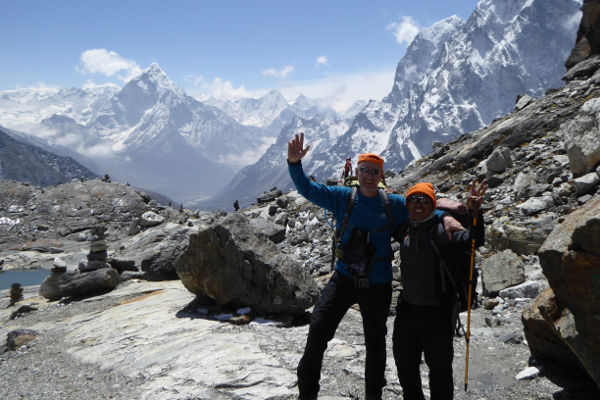
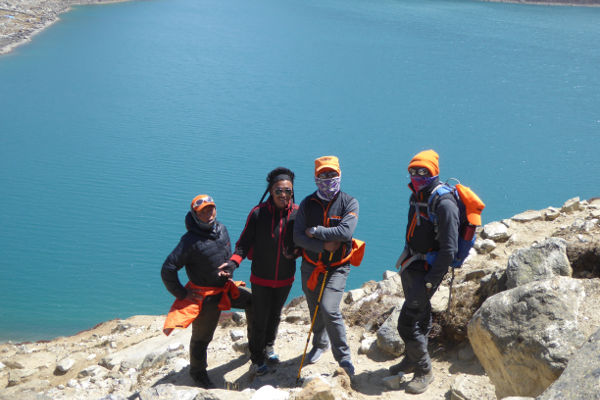

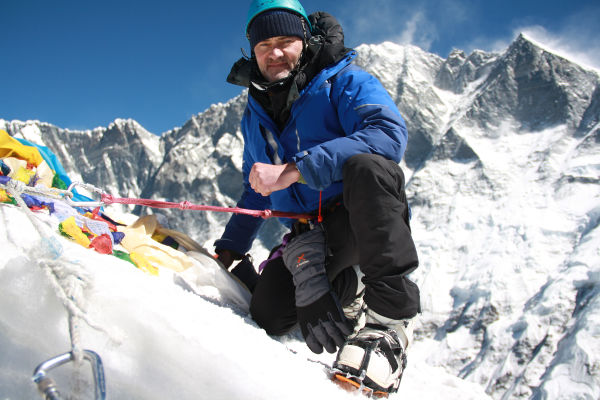
Planning to do EBC via Jiri, how easy to spot the route from Jiri? Can you get lost in that route?
Is travelling solo without guide/porter frowned upon?
I kinda wanted to trek in my own pace and stay longer in between village.
Hi, the route is fairly easy to follow and there are lots of villages along the way so you can always ask if you get a little lost. I recommend taking a good map and compass though, just in case. Certainly not frowned upon to walk it alone, although if you can supply some work for a local guide or porter that is always appreciated.
Here is the sixth thing nobody tells about EBC trek: better alternate route to EBC replacing the run-of-the-mill Tengpoche trail.
It seems to be the best kept secret in Khumbu that there is a much better scenic route opposite side of Tengpoche offering just amazing views across the valley. All trekkers doing only EBC (no Gokyo, that is) should go up this way, and visit Tengpoche on the way down. Thus the itinerary on the way up should be Lukla – Monjo – Namche (2) – Mong La (lunch) – Phortse – Pangpoche (lunch) – Dingpoche (2) – Lobuche – etc.
Several big name agencies have started using this route on the way up (NatGeo, Adventure Consultants etc).
Even better is one where the first night in DIngpoche is replaced by a visit and overnight at Ama Dablam Base Camp, or actually Mingbo Lodge few hundred meters south from there. As the lodge is at the same altitude as DIngpoche (4300m). Thus the ultimate itnerary is Lukla – Monjo – Namche (2) – Mong La (lunch) – Phortse – Pangpoche (lunch) – ADBC – Pangpoche/Shomare (lunch) – Dingpoche – Lobuche – Kala Pattar, and back via Tengpoche.
Thanks for the insight Petrus.
I wish to summit island after covering 3 passes and starting from jiri . Duration and cost pls. Solo trekkers. 62. From India only.
Hi Goutam, you can get a quote here: https://ebctrekguide.com/go
Unless the Jiri portion of the trek has changed since I did it more than 30 years ago, the altitude profile graph is incorrect, suggesting as it does that you don’t reach 3,000 metres till well past Lukla. According to Stephen Bezruchka’s Trekking in Nepal (the bible, in those day) that I used and still have, the Lamjura pass near Sete is 3,530 metres high. Further along the trail, past Ringmo, you cross the Tragsindho La pass at 3,071 metres. Then, after descending to the Dudh Kosi at 1,493 metres, you climb to Khari La at 3,078 metres. All this before Lukla, and with large descents between the high passes. The advantage of having all these high passes prior to Lukla is that it means you’ll be much better acclimated to the higher elevations after Namche than those trekkers who fly into Lukla.
Hi Brian, thanks for getting in touch. Your are indeed correct, the altitude profile graph was mapping the end to end points for each day and ignoring the passes – not very helpful. I have removed it and will get our editor to update for clarity. Thanks for spotting that and pointing it out!
Pls help me
In
Reaching to
Ebc
Hi Ajay, not sure what your question is?